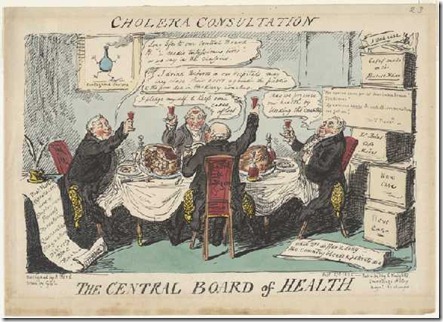Poor housing, overcrowding and high levels of disease, often held to have been exacerbated by the massive influx of Irish migrants, were certainly perceived as problems by those with power and authority in the Victorian city and by politicians at Westminster. Despite prevailing laissez-faire attitudes, the development of municipal intervention in various areas of the urban environment reveals a genuine crisis in urban living conditions with an increasing gap between public expectations and the realities of urban life. Much as they might have wished to, neither local nor national politicians could ignore urban living conditions. The increasing amount of statistical and other information was discussed and publicised by local societies and used as propaganda by medical men and others with first-hand experience of life in the slums. Edwin Chadwick[1] was the best-known propagandist, but at the local level many influential people became increasingly aware and concerned about conditions of urban life. Such evidence was unlikely to have been enough on its own to persuade ratepayers and their elected representatives to pass legislation and spend money improving housing and sanitation for the working-class. Self-interest was at the heart of political action. Concerned about events in Europe, politicians genuinely believed that poor living conditions could lead to mass disturbances and urban violence.
The impact of cholera in 1832 and 1848 brought home, especially to the middle-classes, the fact that disease affected all classes. The poor were blamed for the disease, but it was in the interests of the middle-classes to improve conditions and prevent it recurring. Intervention was also rationalised through economic self-interest since a reduction in disease and improvement in housing would bring about a more efficient workforce and therefore benefit industrialists and entrepreneurs. But there were also important constraints. The contrast between political reaction to Chadwick‘s contribution to the Poor Law Report in 1834 and reaction to his 1842 public health report is instructive. In 1834, legislation rapidly followed the Report while it took six years to produce the public health legislation Chadwick wanted. In 1834, Chadwick was expressing commonly held assumptions across a broad spectrum of society, whereas in 1842 he was radical and original and his ideas had far less support. If things were so bad why did neither central nor local government seem to do anything about it?
The Central Board of Health: Cholera Consultation
George Cruikshank, 1832
There were four important reasons for this situation. Today services such sewage disposal, street lighting and paving is provided by one local authority. Before 1835, many of the growing industrial towns did not have a Royal Charter and therefore did not have a Town Council. Where councils existed they were often corrupt and inefficient; self-perpetuating rather than elected and unaccountable for the ways in which they used the local rates. In some towns power was in the hands of the parish vestry that was elected by property owners. Most towns before 1835 tried to deal with ‘nuisances’ like water supply and drainage using Improvement Commissions. The problem was that each Commission dealt with a specific area of health not the whole package. There was consequently confusion and lack of co-ordination. Local government reform occurred with the Municipal Corporations Act 1835 that provided for elections every three years by the ratepayers of the town councils. It also allowed rates to be levied for street lighting, fresh water-supply and sewage disposal but this took a local Act of Parliament
The chaotic nature of local government militated against effective reform and so too did self-interest. Various groups in towns opposed interference with the existing situation largely because they were in search of profit. Water companies, for example, only supplied water to those areas of a town where the householders could afford the fees. Builders exploited the demand for cheap jerry-built housing and paid little attention to drainage, ventilation or water supply. Private landlords were reluctant to pay the cost of sanitary improvements and were reluctant to accept any responsibility for the cleanliness of the working-classes. Thirdly, there is also the suggestion that middle-class families were either ignorant of the real conditions in which the working-classes lived or were prepared to ignore them. Middle-class houses were built on the edge of towns and were worlds apart from the inner-city slums. Finally there was the question of who was responsibility for public health. How far should central government dictate to local government with regard to the problem? Initially laissez-faire attitudes meant that central government was reluctant to intervene directly in public health issues while local authorities were resistant to solutions imposed on them.
Whatever the reasons, the second half of the nineteenth century saw unprecedented activity in the passing of both by-laws and national legislation affecting urban living conditions. Local legislation was in practice more important than that passed by Parliament: national legislation often included what had previously occurred at a local level. Although the Public Health Act 1848 did not effect any major changes in urban areas, it was the culmination of a concerted public health campaign in England and Wales, marking acceptance of the fact that public health was an issue of national importance. Not until the Sanitary Act 1866 were local Authorities obliged to provide a proper water supply, drainage and sewerage system but the legislation lacked teeth to enforce its powers. Many towns acted independently: Manchester, for instance, took control of the city’s water supply in 1851. But powers to force Local Authorities to act to improve water supply and sanitation did not become effective until the 1875 and especially 1890 Public Health Acts.
[1] On Chadwick see, Lewis, R.A., Edwin Chadwick and the Public Health Movement 1832-1854, (Longman), 1952, Finer, S.E., The Life and Times of Sir Edwin Chadwick, (Methuen), 1952 and Brundage, A., England’s ‘Prussian Minister’: Edwin Chadwick and the Politics of Government Growth 1832-1854, (Pennsylvania University Press), 1988. Hamlin, C., Public health and social justice in the age of Chadwick, (Cambridge University Press), 1998 is essential.

No comments:
Post a Comment